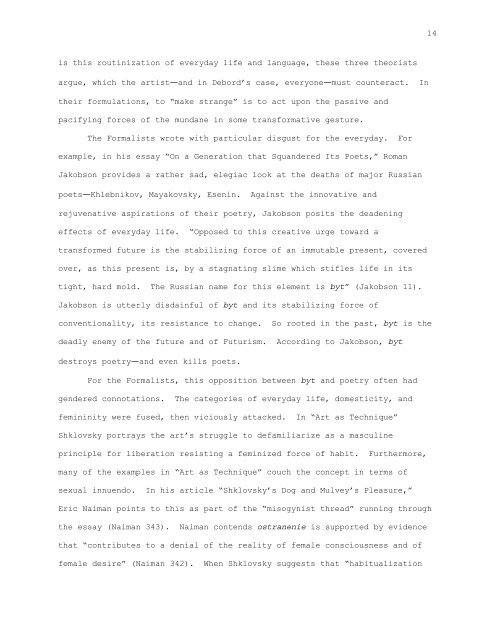Defamiliarization - Audrey Watters
Defamiliarization - Audrey Watters
Defamiliarization - Audrey Watters
You also want an ePaper? Increase the reach of your titles
YUMPU automatically turns print PDFs into web optimized ePapers that Google loves.
is this routinization of everyday life and language, these three theorists<br />
argue, which the artist—and in Debord’s case, everyone—must counteract. In<br />
their formulations, to “make strange” is to act upon the passive and<br />
pacifying forces of the mundane in some transformative gesture.<br />
The Formalists wrote with particular disgust for the everyday. For<br />
example, in his essay “On a Generation that Squandered Its Poets,” Roman<br />
Jakobson provides a rather sad, elegiac look at the deaths of major Russian<br />
poets—Khlebnikov, Mayakovsky, Esenin. Against the innovative and<br />
rejuvenative aspirations of their poetry, Jakobson posits the deadening<br />
effects of everyday life. “Opposed to this creative urge toward a<br />
transformed future is the stabilizing force of an immutable present, covered<br />
over, as this present is, by a stagnating slime which stifles life in its<br />
tight, hard mold. The Russian name for this element is byt” (Jakobson 11).<br />
Jakobson is utterly disdainful of byt and its stabilizing force of<br />
conventionality, its resistance to change. So rooted in the past, byt is the<br />
deadly enemy of the future and of Futurism. According to Jakobson, byt<br />
destroys poetry—and even kills poets.<br />
For the Formalists, this opposition between byt and poetry often had<br />
gendered connotations. The categories of everyday life, domesticity, and<br />
femininity were fused, then viciously attacked. In “Art as Technique”<br />
Shklovsky portrays the art’s struggle to defamiliarize as a masculine<br />
principle for liberation resisting a feminized force of habit. Furthermore,<br />
many of the examples in “Art as Technique” couch the concept in terms of<br />
sexual innuendo. In his article “Shklovsky’s Dog and Mulvey’s Pleasure,”<br />
Eric Naiman points to this as part of the “misogynist thread” running through<br />
the essay (Naiman 343). Naiman contends ostranenie is supported by evidence<br />
that “contributes to a denial of the reality of female consciousness and of<br />
female desire” (Naiman 342). When Shklovsky suggests that “habitualization<br />
14


